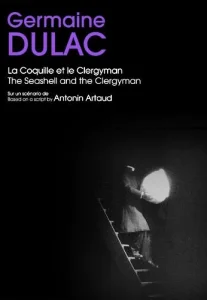Whispers of Desire: How 'The Seashell and the Clergyman' (1928) Shattered Gender and Sexuality on Screen!
The Seashell and the Clergyman
(France, 1928, Germaine Dulac, 41 minutes)
In the revolutionary ferment of 1920s French avant-garde cinema, amidst the rising tide of Surrealism and the burgeoning exploration of psychoanalysis, Germaine Dulac emerged as a pioneering director, a fiercely independent artist whose work pushed the boundaries of cinematic expression and challenged societal norms. Dulac, a leading figure of French Impressionist and experimental film, was not only one of the few prominent female directors of her time but also a fearless explorer of subjective experience, dream logic, and the complexities of human desire. The Seashell and the Clergyman (1928), or La Coquille et le Clergyman, stands as a monumental work, a visually astonishing and psychologically rich film that is widely considered the first Surrealist film ever made, preceding even Buñuel and Dalí's Un Chien Andalou. It shattered conventional narrative, unapologetically delved into themes of repressed sexuality and gender fluidity, and established Dulac's genius for translating inner turmoil into a visceral cinematic experience.
The film plunges us into the tormented subconscious of a young clergyman (played by Alexandre Arquillière) who is consumed by an intense, erotic obsession with the wife of a general (Génica Athanasiou). What unfolds is a hallucinatory, non-linear odyssey through his repressed desires, anxieties, and the absurd manifestations of his forbidden longing. Dulac employs a dazzling array of avant-garde techniques—dissolves, superimpositions, slow motion, rapid cuts, and distorted perspectives—to create a dreamlike, disorienting atmosphere where logic collapses and symbolic imagery reigns supreme. The clergyman pursues the woman through a landscape that constantly shifts and morphs, reflecting his inner turmoil and the societal taboos that bind him. The film's bold portrayal of sexuality, its challenging of traditional gender roles through the clergyman's fluid desires, and its relentless psychological intensity make it a daring and unforgettable piece of early cinematic art, a testament to Dulac's revolutionary vision.
Director: Germaine Dulac.
Cast: Alexandre Arquillière as The Clergyman, Génica Athanasiou as The General's Wife / The Young Woman, and Lucien Bataille as The General.
Special Info/Trivia: The Seashell and the Clergyman is widely considered the first Surrealist film ever made, predating Un Chien Andalou. It was written by Antonin Artaud, a prominent figure in French Surrealism, though Artaud later famously disavowed Dulac's interpretation. Germaine Dulac was a pioneering female director in French cinema and a key figure in the Impressionist and avant-garde movements. The film explores radical themes of sexuality, repression, and gender fluidity for its time. It was initially met with controversy and even a riot at its premiere, but has since been reclaimed as a crucial work in film history.

